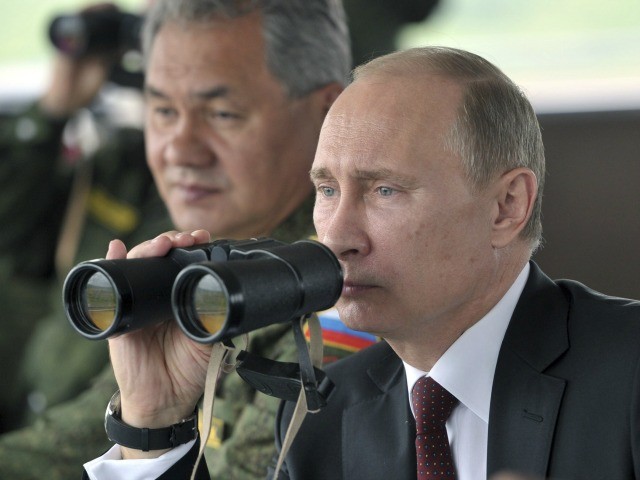In the aftermath of Vladimir Putin’s Russian annexation of Crimea – and in the wake of the Obama administration’s tepid response, amounting to a slap on the wrist directed at a specific few individuals who seem less than perturbed by the blowback – the question now on the table is just how far Russia’s territorial ambitions extend.
It seems clear that no one either in Europe or in the White House has the will to take effective measures against the Russians in situations in which Russia can manufacture consent for annexation. Despite Vice President Joe Biden’s assurances to Poland and Lithuania that more sanctions are on their way, and despite a multiplicity of promises made to the interim Ukrainian government about standing up to Russian bullying, Putin seems less than deterred. And the United States has thus far rejected Sen. John McCain’s (R-AZ) suggestion that we begin arming the Ukrainian military, even though reports broke today of Russian troops firing at Ukrainian troops.
The media handwringing over whether Putin is “crazy” obscures the fact that Putin is a very smart power player on the world stage. He is also representative of a former Communist infrastructure consumed with expansionism. Remember, that famed peacenik Mikhael Gorbachev supports Putin’s annexation of Crimea (which should put an end to discussion over whether Reagan won the Cold War or Gorbachev was just a good-hearted fellow looking for an out).
So, what’s next for Russia? Clearly, Poland and the rest of Ukraine would likely be a bridge too far at this point; that’s why Putin has bothered putting together a rigged plebiscite in Crimea. But Russian ambitions don’t have to end at Sevastopol.
Here, then, are the top four possibilities for a Russian territorial extension:
Moldova. On Tuesday, politicians in the Trans-Dniestrian region of Moldova, which marks the eastern border of the country, asked the Russian Duma to draft law allowing them to join the mother country. Moldova separates Ukraine from Romania on the map. Moldova’s President Nicolae Timofti says that should Moscow do that, it “would be a step in the wrong direction.” But as early as September 2006, Trans-Dniester sought to break off from Moldova and go independent. According to Irina Kubanskikh, spokeswoman for the Trans-Dniestrian parliament, the political leaders of the region are appealing to “the Russian Federation leadership to examine the possibility of extending to Trans-Dniester the legislation, currently under discussion in the State Duma, on granting Russian citizenship and admitting new subjects into Russia.”
Were this region to join Russia, Russia would undoubtedly seek a land bridge between Crimea and Moldova through Ukrainian territory. Ukraine would effectively be surrounded from both East and West by Russian countries. Russia does maintain a military presence in Trans-Dniester already.
Georgia. In 2008, Russian troops invaded two provinces of Georgia, supposedly to defend the safety of ethnic Russians in South Ossetia and Abkhazia. The west threatened sanctions; instead, Russian troops remain in both regions, and sanctions were never put in place. Georgia is located to the south of Russia and along the Black Sea, separating Russia from Turkey. Russia has long had territorial ambitions in Turkey, given its proximity to the Black Sea and its access to the Middle East.
Kazakhstan. This oil-rich country to Russia’s south has a huge population of ethnic Russians, and ethnic Russians in the region have historically felt disadvantaged by what some feel is a rigged political process. Hundreds of thousands of ethnic Russians left the country for the mother country after the Cold War. Kazakh is the official language of the country, alienating many ethnic Russians. Early in his administration, Putin met with Russian leaders in Kazakhstan who were seeking resources to come to Russia. That idea died when Putin didn’t provide the resources. But the presence of a heavy Russian population in Kazakhstan could prompt Russian intervention instead, particularly in the northern regions of the country.
Belarus. The Belarusian government is strongly allied with Vladimir Putin and the Kremlin, with President Alexander Lukashenko – who has led the country essentially since the dissolution of the Soviet Union – telling Putin to go ahead and base 12 to 15 fighter jets in his country to intimidate the Ukrainians. Approximately 1.2 million Russians live in Belarus, amounting to some 11% of the country. Belarus borders Ukraine to the north and Lithuania, Latvia, and Poland in the East. Russian is an official language of the country, along with Belarusian. There’s no rationale for Russia to expend resources in Belarus, given that it is basically a proxy state. But were the political situation to change on the ground, that could shift rapidly.
None of these countries are members of NATO. In all likelihood, Putin would consolidate his gains before moving against the rest of Ukraine or any of the NATO countries, including Estonia (25.5% Russian), Latvia (27.6% Russian), and Lithuania (5.8% Russian). Putin will instead focus on his burgeoning power in the Middle East thanks to President Obama’s feckless foreign policy with regard to Syria and Iran. Creating a world consortium of gas producers to threaten Western energy supply would be the short-term goal; the long-term goal would be to reconstitute Russian power through both territorial and economic expansion.
So far, the plan is working to perfection.
Ben Shapiro is Senior Editor-At-Large of Breitbart News and author of the New York Times bestseller “Bullies: How the Left’s Culture of Fear and Intimidation Silences America” (Threshold Editions, January 8, 2013). He is also Editor-in-Chief of TruthRevolt.org. Follow Ben Shapiro on Twitter @benshapiro.

COMMENTS
Please let us know if you're having issues with commenting.